Jonathan DeCastro
Estimating cognitive biases with attention-aware inverse planning
Oct 29, 2025Abstract:People's goal-directed behaviors are influenced by their cognitive biases, and autonomous systems that interact with people should be aware of this. For example, people's attention to objects in their environment will be biased in a way that systematically affects how they perform everyday tasks such as driving to work. Here, building on recent work in computational cognitive science, we formally articulate the attention-aware inverse planning problem, in which the goal is to estimate a person's attentional biases from their actions. We demonstrate how attention-aware inverse planning systematically differs from standard inverse reinforcement learning and how cognitive biases can be inferred from behavior. Finally, we present an approach to attention-aware inverse planning that combines deep reinforcement learning with computational cognitive modeling. We use this approach to infer the attentional strategies of RL agents in real-life driving scenarios selected from the Waymo Open Dataset, demonstrating the scalability of estimating cognitive biases with attention-aware inverse planning.
Timing the Message: Language-Based Notifications for Time-Critical Assistive Settings
Sep 09, 2025Abstract:In time-critical settings such as assistive driving, assistants often rely on alerts or haptic signals to prompt rapid human attention, but these cues usually leave humans to interpret situations and decide responses independently, introducing potential delays or ambiguity in meaning. Language-based assistive systems can instead provide instructions backed by context, offering more informative guidance. However, current approaches (e.g., social assistive robots) largely prioritize content generation while overlooking critical timing factors such as verbal conveyance duration, human comprehension delays, and subsequent follow-through duration. These timing considerations are crucial in time-critical settings, where even minor delays can substantially affect outcomes. We aim to study this inherent trade-off between timeliness and informativeness by framing the challenge as a sequential decision-making problem using an augmented-state Markov Decision Process. We design a framework combining reinforcement learning and a generated offline taxonomy dataset, where we balance the trade-off while enabling a scalable taxonomy dataset generation pipeline. Empirical evaluation with synthetic humans shows our framework improves success rates by over 40% compared to methods that ignore time delays, while effectively balancing timeliness and informativeness. It also exposes an often-overlooked trade-off between these two factors, opening new directions for optimizing communication in time-critical human-AI assistance.
Dreaming to Assist: Learning to Align with Human Objectives for Shared Control in High-Speed Racing
Oct 14, 2024Abstract:Tight coordination is required for effective human-robot teams in domains involving fast dynamics and tactical decisions, such as multi-car racing. In such settings, robot teammates must react to cues of a human teammate's tactical objective to assist in a way that is consistent with the objective (e.g., navigating left or right around an obstacle). To address this challenge, we present Dream2Assist, a framework that combines a rich world model able to infer human objectives and value functions, and an assistive agent that provides appropriate expert assistance to a given human teammate. Our approach builds on a recurrent state space model to explicitly infer human intents, enabling the assistive agent to select actions that align with the human and enabling a fluid teaming interaction. We demonstrate our approach in a high-speed racing domain with a population of synthetic human drivers pursuing mutually exclusive objectives, such as "stay-behind" and "overtake". We show that the combined human-robot team, when blending its actions with those of the human, outperforms the synthetic humans alone as well as several baseline assistance strategies, and that intent-conditioning enables adherence to human preferences during task execution, leading to improved performance while satisfying the human's objective.
Computational Teaching for Driving via Multi-Task Imitation Learning
Oct 02, 2024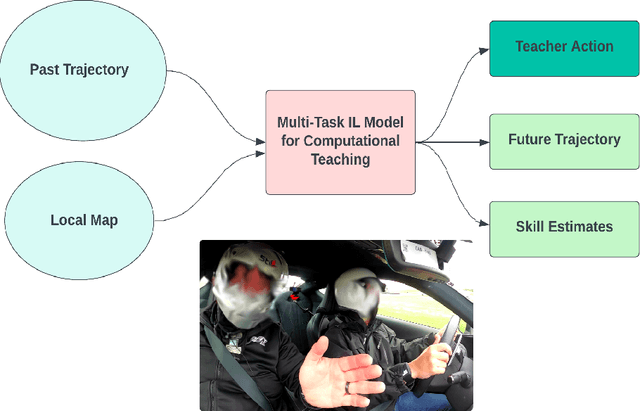
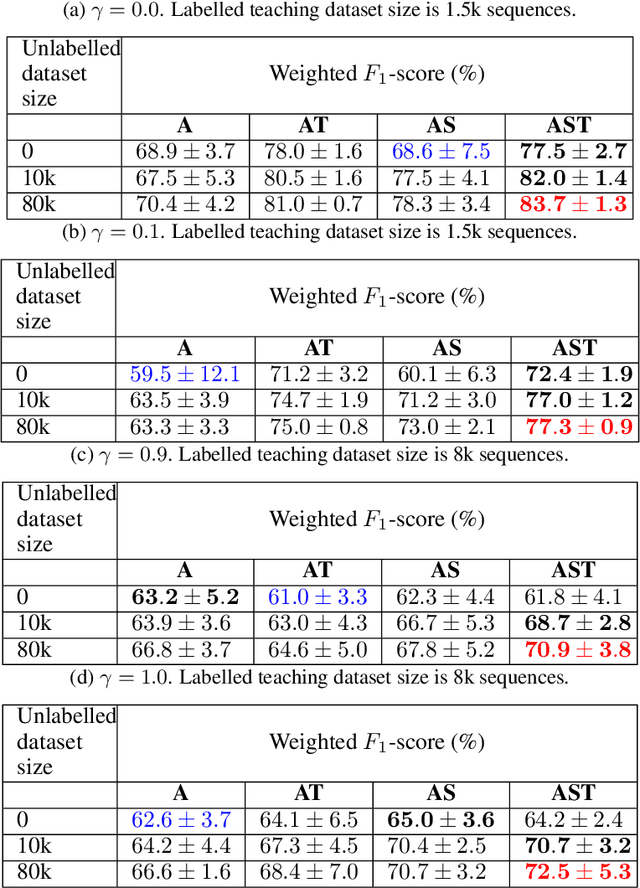

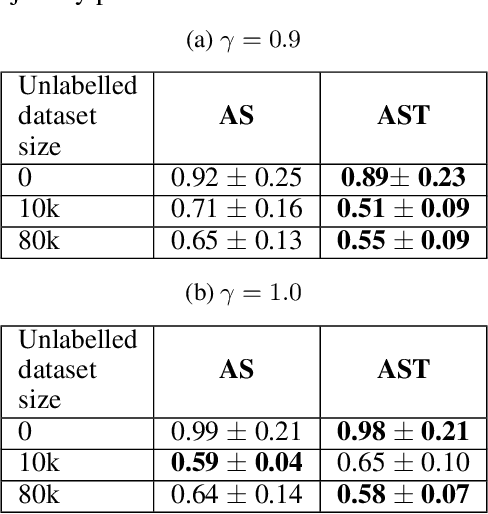
Abstract:Learning motor skills for sports or performance driving is often done with professional instruction from expert human teachers, whose availability is limited. Our goal is to enable automated teaching via a learned model that interacts with the student similar to a human teacher. However, training such automated teaching systems is limited by the availability of high-quality annotated datasets of expert teacher and student interactions that are difficult to collect at scale. To address this data scarcity problem, we propose an approach for training a coaching system for complex motor tasks such as high performance driving via a Multi-Task Imitation Learning (MTIL) paradigm. MTIL allows our model to learn robust representations by utilizing self-supervised training signals from more readily available non-interactive datasets of humans performing the task of interest. We validate our approach with (1) a semi-synthetic dataset created from real human driving trajectories, (2) a professional track driving instruction dataset, (3) a track-racing driving simulator human-subject study, and (4) a system demonstration on an instrumented car at a race track. Our experiments show that the right set of auxiliary machine learning tasks improves performance in predicting teaching instructions. Moreover, in the human subjects study, students exposed to the instructions from our teaching system improve their ability to stay within track limits, and show favorable perception of the model's interaction with them, in terms of usefulness and satisfaction.
Think Deep and Fast: Learning Neural Nonlinear Opinion Dynamics from Inverse Dynamic Games for Split-Second Interactions
Jun 14, 2024



Abstract:Non-cooperative interactions commonly occur in multi-agent scenarios such as car racing, where an ego vehicle can choose to overtake the rival, or stay behind it until a safe overtaking "corridor" opens. While an expert human can do well at making such time-sensitive decisions, the development of safe and efficient game-theoretic trajectory planners capable of rapidly reasoning discrete options is yet to be fully addressed. The recently developed nonlinear opinion dynamics (NOD) show promise in enabling fast opinion formation and avoiding safety-critical deadlocks. However, it remains an open challenge to determine the model parameters of NOD automatically and adaptively, accounting for the ever-changing environment of interaction. In this work, we propose for the first time a learning-based, game-theoretic approach to synthesize a Neural NOD model from expert demonstrations, given as a dataset containing (possibly incomplete) state and action trajectories of interacting agents. The learned NOD can be used by existing dynamic game solvers to plan decisively while accounting for the predicted change of other agents' intents, thus enabling situational awareness in planning. We demonstrate Neural NOD's ability to make fast and robust decisions in a simulated autonomous racing example, leading to tangible improvements in safety and overtaking performance over state-of-the-art data-driven game-theoretic planning methods.
Blending Data-Driven Priors in Dynamic Games
Feb 23, 2024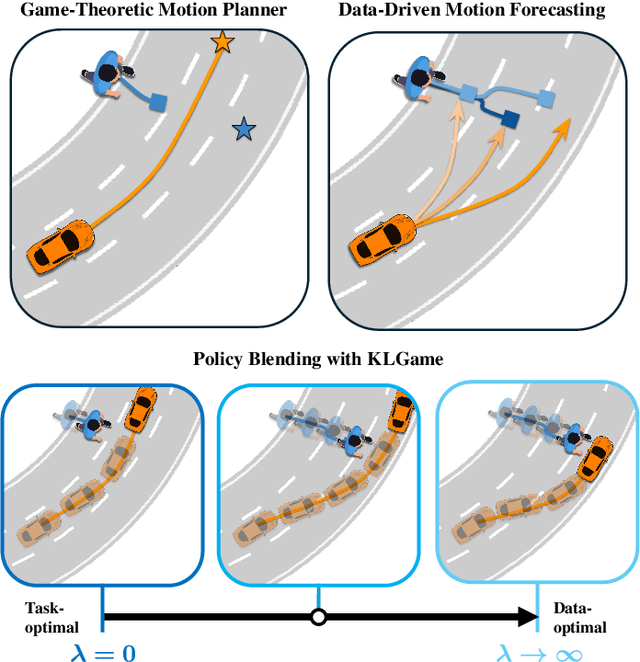

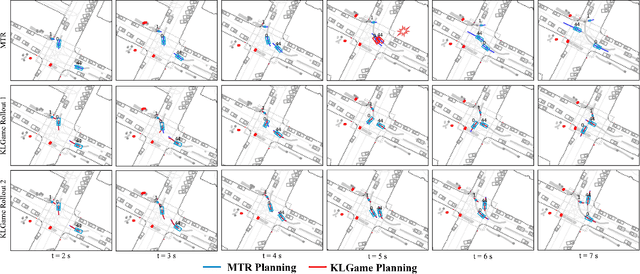
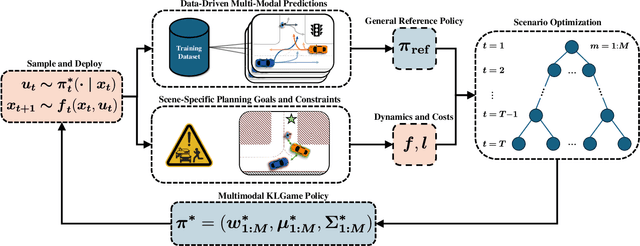
Abstract:As intelligent robots like autonomous vehicles become increasingly deployed in the presence of people, the extent to which these systems should leverage model-based game-theoretic planners versus data-driven policies for safe, interaction-aware motion planning remains an open question. Existing dynamic game formulations assume all agents are task-driven and behave optimally. However, in reality, humans tend to deviate from the decisions prescribed by these models, and their behavior is better approximated under a noisy-rational paradigm. In this work, we investigate a principled methodology to blend a data-driven reference policy with an optimization-based game-theoretic policy. We formulate KLGame, a type of non-cooperative dynamic game with Kullback-Leibler (KL) regularization with respect to a general, stochastic, and possibly multi-modal reference policy. Our method incorporates, for each decision maker, a tunable parameter that permits modulation between task-driven and data-driven behaviors. We propose an efficient algorithm for computing multimodal approximate feedback Nash equilibrium strategies of KLGame in real time. Through a series of simulated and real-world autonomous driving scenarios, we demonstrate that KLGame policies can more effectively incorporate guidance from the reference policy and account for noisily-rational human behaviors versus non-regularized baselines.
A Preference Learning Approach to Develop Safe and Personalizable Autonomous Vehicles
Oct 30, 2023Abstract:This work introduces a preference learning method that ensures adherence to traffic rules for autonomous vehicles. Our approach incorporates priority ordering of signal temporal logic (STL) formulas, describing traffic rules, into a learning framework. By leveraging the parametric weighted signal temporal logic (PWSTL), we formulate the problem of safety-guaranteed preference learning based on pairwise comparisons, and propose an approach to solve this learning problem. Our approach finds a feasible valuation for the weights of the given PWSTL formula such that, with these weights, preferred signals have weighted quantitative satisfaction measures greater than their non-preferred counterparts. The feasible valuation of weights given by our approach leads to a weighted STL formula which can be used in correct-and-custom-by-construction controller synthesis. We demonstrate the performance of our method with human subject studies in two different simulated driving scenarios involving a stop sign and a pedestrian crossing. Our approach yields competitive results compared to existing preference learning methods in terms of capturing preferences, and notably outperforms them when safety is considered.
GAME-UP: Game-Aware Mode Enumeration and Understanding for Trajectory Prediction
May 28, 2023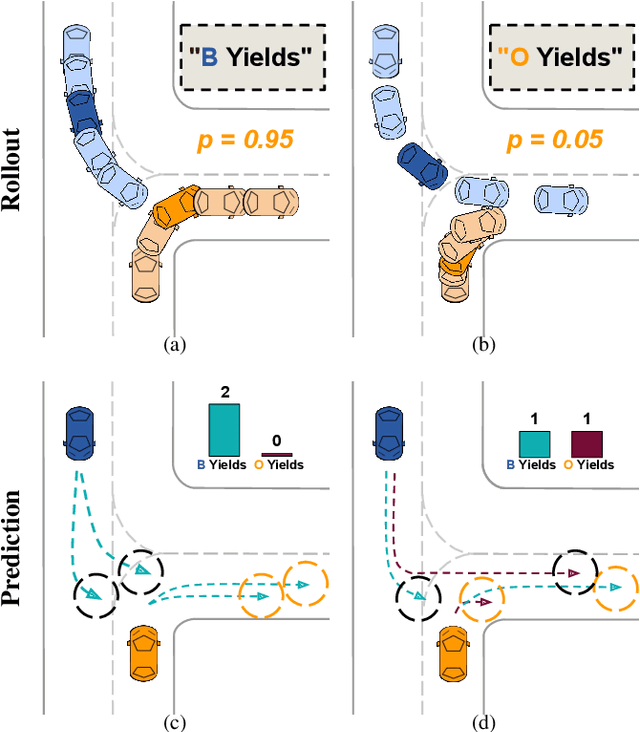

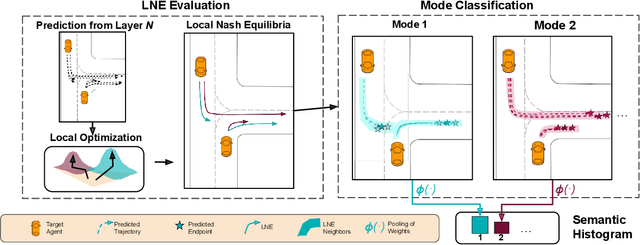
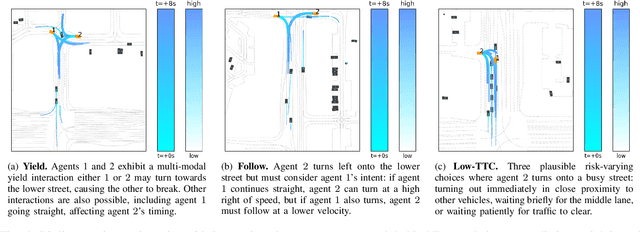
Abstract:Interactions between road agents present a significant challenge in trajectory prediction, especially in cases involving multiple agents. Because existing diversity-aware predictors do not account for the interactive nature of multi-agent predictions, they may miss these important interaction outcomes. In this paper, we propose GAME-UP, a framework for trajectory prediction that leverages game-theoretic inverse reinforcement learning to improve coverage of multi-modal predictions. We use a training-time game-theoretic numerical analysis as an auxiliary loss resulting in improved coverage and accuracy without presuming a taxonomy of actions for the agents. We demonstrate our approach on the interactive subset of Waymo Open Motion Dataset, including three subsets involving scenarios with high interaction complexity. Experiment results show that our predictor produces accurate predictions while covering twice as many possible interactions versus a baseline model.
Specification-Guided Data Aggregation for Semantically Aware Imitation Learning
Mar 29, 2023



Abstract:Advancements in simulation and formal methods-guided environment sampling have enabled the rigorous evaluation of machine learning models in a number of safety-critical scenarios, such as autonomous driving. Application of these environment sampling techniques towards improving the learned models themselves has yet to be fully exploited. In this work, we introduce a novel method for improving imitation-learned models in a semantically aware fashion by leveraging specification-guided sampling techniques as a means of aggregating expert data in new environments. Specifically, we create a set of formal specifications as a means of partitioning the space of possible environments into semantically similar regions, and identify elements of this partition where our learned imitation behaves most differently from the expert. We then aggregate expert data on environments in these identified regions, leading to more accurate imitation of the expert's behavior semantics. We instantiate our approach in a series of experiments in the CARLA driving simulator, and demonstrate that our approach leads to models that are more accurate than those learned with other environment sampling methods.
Analyzing Multiagent Interactions in Traffic Scenes via Topological Braids
Sep 15, 2021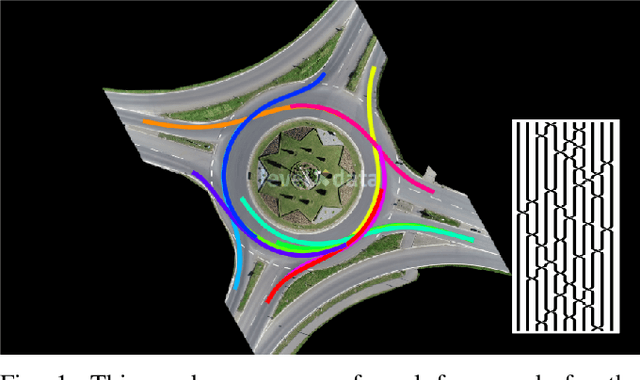

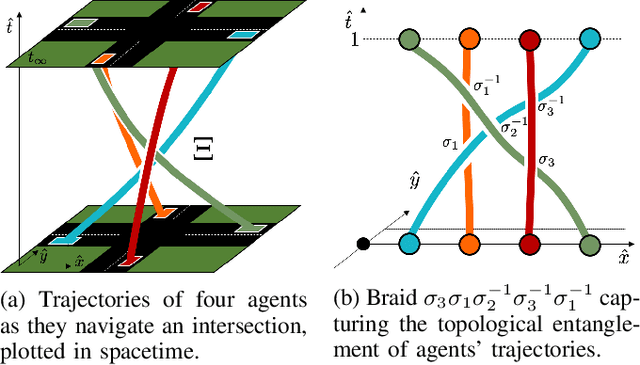

Abstract:We focus on the problem of analyzing multiagent interactions in traffic domains. Understanding the space of behavior of real-world traffic may offer significant advantages for algorithmic design, data-driven methodologies, and benchmarking. However, the high dimensionality of the space and the stochasticity of human behavior may hinder the identification of important interaction patterns. Our key insight is that traffic environments feature significant geometric and temporal structure, leading to highly organized collective behaviors, often drawn from a small set of dominant modes. In this work, we propose a representation based on the formalism of topological braids that can summarize arbitrarily complex multiagent behavior into a compact object of dual geometric and symbolic nature, capturing critical events of interaction. This representation allows us to formally enumerate the space of outcomes in a traffic scene and characterize their complexity. We illustrate the value of the proposed representation in summarizing critical aspects of real-world traffic behavior through a case study on recent driving datasets. We show that despite the density of real-world traffic, observed behavior tends to follow highly organized patterns of low interaction. Our framework may be a valuable tool for evaluating the richness of driving datasets, but also for synthetically designing balanced training datasets or benchmarks.
 Add to Chrome
Add to Chrome Add to Firefox
Add to Firefox Add to Edge
Add to Edge